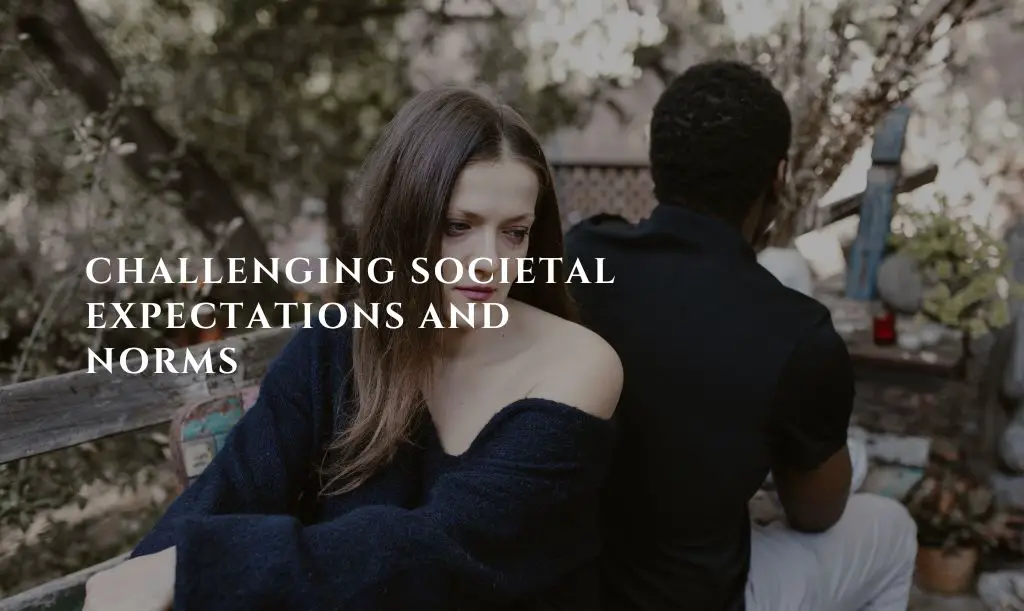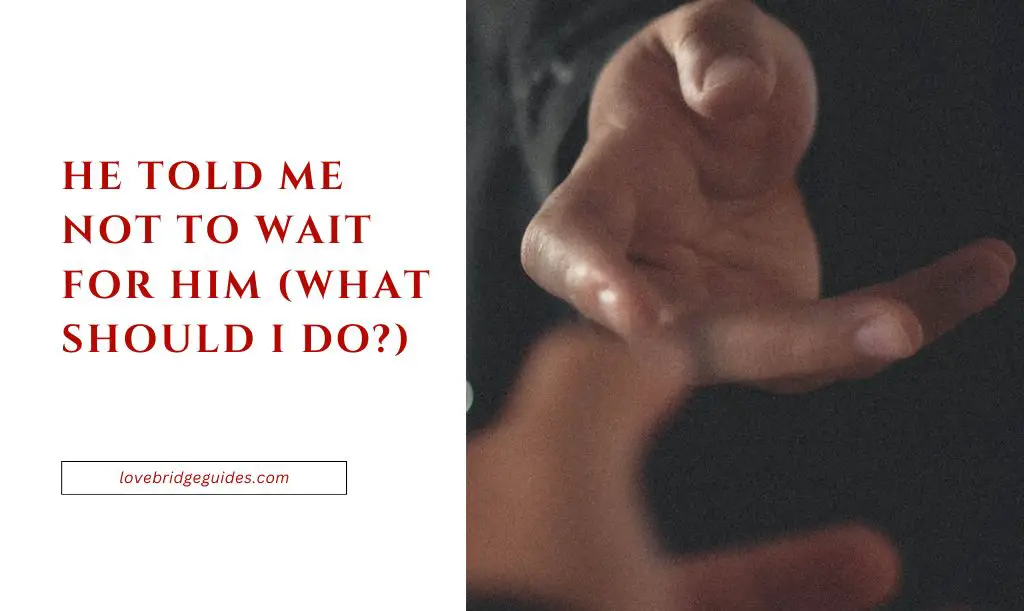‘He told me not to wait for him. What does this mean?’
Picture this: you find yourself standing at a crossroad, eagerly seeking guidance in the labyrinthine maze of life.
And just then, like a mystical sage emerging from the shadows, he appears and utters those bewildering words – “Do not wait for me.”
The enigma of his advice reverberates within your soul, leaving you with a mix of intrigue and frustration.
The Allure Of Forbidden Knowledge
There is an undeniable allure in forbidden knowledge. It’s like staring at a locked box, desperate to uncover its secrets.
And when someone tells you not to wait for them, it’s as if they have handed you the key to that box, tempting you to unlock its mysteries.
Your curiosity piques instantly – why shouldn’t I wait?
What lies beneath their inscrutable words?
In our human nature lies an insatiable desire to understand and decipher puzzles.
We yearn for answers even when they are concealed behind veils of ambiguity.
It is this very allure that draws us deeper into the rabbit hole of introspection.
But be warned!
Seeking answers might lead us down treacherous paths filled with uncertainty and emotional turmoil.
Yet, despite the risks involved, we cannot help but be enticed by the forbidden fruit dangling before us.
In this article, we will embark on a journey to unravel the meaning behind those perplexing words – “he told me not to wait for him.”
Brace yourself as we delve into the complexities of human relationships and examine how these four simple words can influence our perceptions of love, independence, and personal growth.
He Told Me Not To Wait For Him: Who Is “He”

He told me not to wait for him. But who could he possibly be? Is he a boyfriend, a friend, or perhaps a mentor?
The possibilities are endless, and each one carries its own set of implications.
Was there an undeniable romantic connection that existed between you both?
Or was he simply a trusted confidant who offered guidance and wisdom when you needed it most?
The context surrounding this advice can provide valuable clues to unraveling the mystery of his identity.
Analyzing His Character Traits And Motivations
Now let us delve into the depths of his character and motivations.
What kind of person would utter such cryptic advice? Does he possess an air of mystery himself or does he wear his heart on his sleeve?
Is he someone driven by self-interest or guided by genuine concern for your well-being?
Analyzing his character traits can offer invaluable insight into understanding why he delivered this perplexing message.
Perhaps he is afraid of commitment, haunted by past traumas, or simply unable to reciprocate the depth of your feelings.
Or maybe, just maybe, his intentions are rooted in a profound understanding of life’s complexities and a desire to see you thrive.
Decoding The Meaning Behind “Not To Wait For Him”
Now we come to the crux of the matter – decoding the meaning behind those four haunting words: “not to wait for him.”
Does it hold a literal interpretation, suggesting that he will not be returning anytime soon?
That your paths have diverged irreparably?
Or is it more metaphorical in nature, urging you not to put your life on hold for someone who may never fully reciprocate your love?
Perhaps there are hidden implications within those words that speak volumes about both his emotions and yours.
It is within this decoding process that we can unveil the underlying emotions and gain a deeper understanding of what lies beneath the surface.
The Power of Independence

In a world that often emphasizes the importance of companionship and finding “the one,” it is easy to overlook the immense value of personal growth and self-discovery.
Society constantly bombards us with images of couples living happily ever after, reinforcing the idea that our ultimate fulfillment lies in the arms of another person.
However, by heeding the advice to not wait for him, we open ourselves up to a world of possibilities – a world where our own growth and happiness take precedence over meeting societal expectations.
Embracing personal growth means embarking on a journey of self-reflection, exploration, and continuous learning.
It allows us to uncover our true passions, hone our skills, and discover what truly brings us joy.
Encouraging Autonomy And Self-Reliance
Waiting for someone implies reliance on their presence or actions for our own happiness.
It is an act that surrenders our autonomy, placing it in the hands of another individual.
By embracing independence instead, we acknowledge our ability to navigate life’s challenges on our own terms.
We become captains of our own ships, charting new courses regardless of whether there is someone waiting at the shore or not.
Autonomy empowers us to make decisions based on what aligns with our values and desires rather than conforming to societal norms or expectations set by others.
The Transformative Effects Of Letting Go
Letting go can be one of the most liberating and transformative experiences we can undertake.
It is an act of consciously releasing attachments that no longer serve us – whether it be a person, a situation, or even an outdated belief system.
When we embrace the advice not to wait for him, we free ourselves from emotional shackles that hinder personal growth.
Letting go allows us to shed the weight of unrequited love or unfulfilling relationships, creating space for new experiences and opportunities.
It paves the way for personal reinvention, as we discover parts of ourselves that may have been overshadowed by our attachment to someone else.
Challenging Societal Expectations And Norms

Society has long dictated the roles and expectations placed upon individuals in relationships.
We are molded to believe that waiting for someone is a sign of dedication and commitment.
However, by defying these traditional roles, we challenge the very fabric of societal expectations.
We refuse to conform to outdated notions that undermine our autonomy and individuality.
Breaking free from these constraints liberates us from the confines of gender stereotypes, allowing us to embrace a more egalitarian approach in defining our own paths.
Empowering Individuals To Forge Their Own Paths
When we heed the advice not to wait for him, we empower ourselves to forge our own paths – ones that are not solely dependent on the choices or actions of another person.
It is an act of reclaiming agency over our lives and taking charge of our destiny.
By stepping away from societal pressures, we give ourselves permission to pursue our passions wholeheartedly, regardless of whether there is a romantic partner by our side or not.
Embracing personal growth, self-reliance, letting go, breaking free from traditional roles, and forging one’s own path are all essential components in harnessing the power of independence.
By following the advice not to wait for him, we embark on a journey towards self-discovery and liberation.
It is through this journey that we truly come into our own; embracing who we are without needing validation or approval from others.
The Dance of Desire and Uncertainty

How often have we found ourselves captivated by someone who advises us against waiting for them?
It is a peculiar paradox, a seductive dance between reason and passion.
Despite all rationality pleading for us to move on, we find ourselves clinging to the hope that defies logic.
There is an undeniable allure in defying advice, as if by waiting, we prove our unwavering commitment and unwarranted faith in a future together.
We convince ourselves that this fervent waiting is a testament to the depth of our love.
But let me tell you this: it is not love; it is naivety dressed up as devotion.
The Thrill of Uncertainty in Relationships
Uncertainty in relationships has been romanticized to such an extent that it has become dangerously misconstrued as thrilling and desirable.
We have somehow convinced ourselves that the more uncertain the path ahead, the greater the intensity of our emotions.
It has become fashionable to revel in the rollercoaster ride of emotions caused by ambiguous signals and mixed messages.
But let me burst this bubble for you: uncertainty breeds instability, not excitement.
True emotional fulfillment does not stem from constantly second-guessing each other’s intentions or playing mind games; it arises from open communication, trust, and shared vulnerability.
Navigating the Fine Line Between Hope and Resignation
The emotional turmoil caused by conflicting desires can be exquisitely agonizing.
On one hand, there is an intense longing for someone who explicitly advises against waiting for them—a desire rooted deep within our core being.
On the other hand, there is the inner voice of reason whispering that it is time to let go and move on.
This tug-of-war between hope and resignation can tear us apart, leaving us feeling lost, confused, and emotionally drained.
But we must understand the psychology behind this longing: it is not love; it is attachment to an idealized version of what could be.
It is the fear of letting go and facing the unknown that keeps us trapped in this emotional purgatory.
To truly find peace within ourselves, we must acknowledge our conflicting desires and summon the courage to choose self-preservation over self-deception.
The dance of desire and uncertainty can be a treacherous one, enticing us with false promises and robbing us of our sanity.
Waiting for someone who advises against it may seem like an act of devotion, but in reality, it’s a disservice to ourselves.
Uncertainty should not be mistaken as excitement; instead, it should be seen as a red flag signaling potential instability.
Navigating the fine line between hope and resignation requires introspection and self-awareness – acknowledging our conflicting desires while understanding their true nature.
The Subtle Art of Letting Go

In the intricate dance of life, there comes a time when we must release our grip on what we hold dear.
Acceptance, my dear reader, is the key to unlocking the door of personal growth.
Embracing the idea that some paths are not meant to be traversed allows us to redirect our energy towards endeavors that serve our higher purpose.
It is through acceptance that we can find solace in the face of disappointment and adversity.
By accepting that “he” told us not to wait, we can liberate ourselves from the shackles of despair and pave a new path towards self-discovery.
Finding Solace In Embracing Change
Change, although often feared and resisted, is an inherent part of life’s tapestry.
When “he” urges us not to wait for him, he is in essence encouraging us to embrace change with open arms.
This act requires courage and an unwavering belief in our own strength.
By surrendering to this inevitability, we can find solace in knowing that every ending births new beginnings.
Change invites opportunities for self-reinvention, allowing us to shed old skin and emerge as more resilient versions of ourselves.
We must learn from this experience by reflecting on what drew us towards him and what kept us tethered when he urged otherwise.
Understanding these patterns allows us to evolve emotionally, making us wiser and more discerning in matters of love.
He Told Me Not To Wait For Him: Conclusion
He told me not to wait for him. What does this mean?
Well, in the grand tapestry of life, there exists a delicate balance between holding on and letting go.
While the advice not to wait for him may sting at first, it is an opportunity for growth and self-discovery.
By accepting this advice, embracing change, and cultivating resilience, we can transcend heartache and forge a new path forward.
Remember that within every ending is the seed of a new beginning.
So let go with grace and optimism, for the universe has beautiful surprises in store for those who dare to release what no longer serves them.
Related Articles:
- https://lovebridgeguides.com/texting-ex-on-anniversary/
- https://lovebridgeguides.com/will-my-ex-regret-leaving-me-for-someone-else/
- Does A Prom Date Mean Anything? (Answered!) - 20 February 2024
- Boyfriend Refers To Me In Third Person (Explained!) - 20 February 2024
- Is Sending Memes Flirting? Find Out Here! - 20 February 2024

